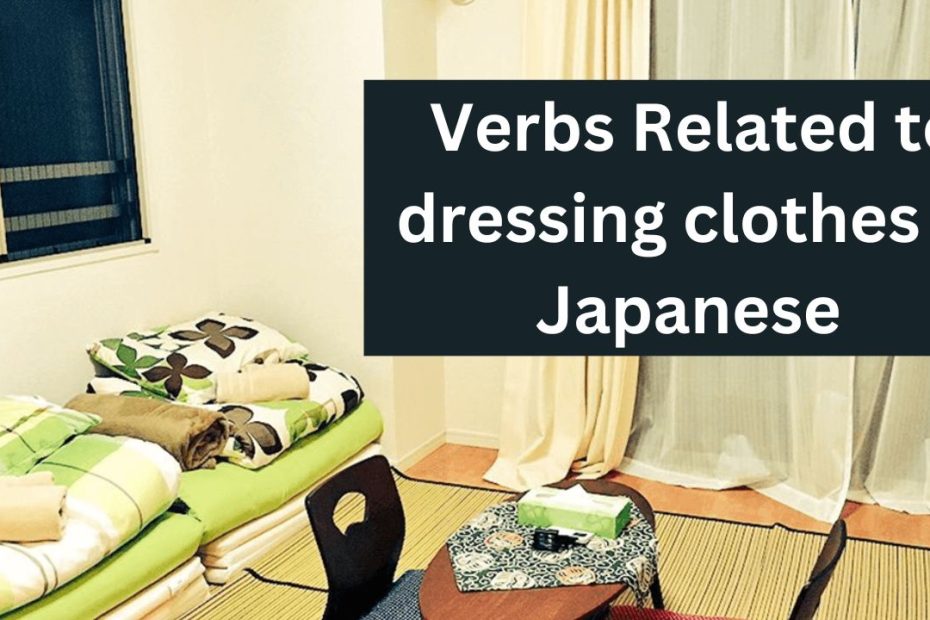Getting Dressed: Essential Japanese Vocabulary and Grammar
In this lesson, we will delve into the fundamental aspects of discussing clothing and getting dressed in Japanese. Understanding how to express oneself in terms of attire is not only practical for everyday conversations but also plays a crucial role in navigating social situations. From basic vocabulary related to clothing items to essential grammar points for forming sentences about getting dressed, this lesson will equip you with the tools to confidently talk about your wardrobe choices in Japanese.
Verbs:
- 着る (きる, Kiru) – To wear (general term for putting on clothes)
- Example: シャツを着る (Shatsu o kiru) – To wear a shirt
- 履く (はく, Haku) – To put on (shoes, pants, socks)
- Example: 靴を履く (Kutsu o haku) – To put on shoes
- かぶる (かぶる, Kaburu) – To put on (hats, caps)
- Example: 帽子をかぶる (Bōshi o kaburu) – To wear a hat
- 着せる (きせる, Kiseru) – To dress someone else (putting clothes on someone)
- Example: 子供に服を着せる (Kodomo ni fuku o kiseru) – To dress a child
- 脱ぐ (ぬぐ, Nugu) – To take off (clothes)
- Example: ジャケットを脱ぐ (Jaketto o nugu) – To take off a jacket
- 巻く (まく, Maku) – To wrap (scarf, towel)
- Example: スカーフを巻く (Sukāfu o maku) – To wrap a scarf
- 付ける (つける, Tsukeru) – To put on (accessories like earrings, necklaces)
- Example: ピアスを付ける (Piasu o tsukeru) – To wear earrings
- 取る (とる, Toru) – To take off (accessories)
- Example: 指輪を取る (Yubiwa o toru) – To take off a ring
- 着がえる (きがえる, Kigaeru) – To change clothes
- Example: 服を着がえる (Fuku o kigaeru) – To change clothes
- 重ねる (かさねる, Kasaneru) – To layer (clothing)
- Example: シャツを重ねる (Shatsu o kasaneru) – To layer shirts
- 装う (よそおう, Yosoou) – To dress up (formally or stylishly)
- Example: ドレスで装う (Doresu de yosoou) – To dress up in a dress
- 留める (とめる, Tomeru) – To fasten (buttons, zippers, etc.)
- Example: ボタンを留める (Botan o tomeru) – To fasten buttons
Vocabulary for clothes:
- シャツ (Shatsu) – Shirt
- ブラウス (Burausu) – Blouse
- ジャケット (Jaketto) – Jacket
- コート (Kōto) – Coat
- ドレス (Doresu) – Dress
- スカート (Sukāto) – Skirt
- パンツ (Pantsu) – Pants
- ジーンズ (Jīnzu) – Jeans
- セーター (Sētā) – Sweater
- パーカー (Pākā) – Hoodie
- タンクトップ (Tankutoppu) – Tank top
- パジャマ (Pajama) – Pajamas
- 靴 (くつ, Kutsu) – Shoes
- ブーツ (Būtsu) – Boots
- サンダル (Sandaru) – Sandals
- 帽子 (ぼうし, Bōshi) – Hat
- 手袋 (てぶくろ, Tebukuro) – Gloves
- ベルト (Beruto) – Belt
- バッグ (Baggu) – Bag
- 財布 (さいふ, Saifu) – Wallet
- ソックス (Sokkusu) – Socks
- ネクタイ (Nekutai) – Necktie
- スカーフ (Sukāfu) – Scarf
- バンダナ (Bandana) – Bandana
- イヤリング (Iyaringu) – Earrings
- ネックレス (Nekkuresu) – Necklace
- 指輪 (ゆびわ, Yubiwa) – Ring
- 腕時計 (うでどけい, Udedokei) – Watch
- メガネ (Megane) – Glasses
- サングラス (Sangurasu) – Sunglasses
Remember that the specific verb used can depend on the type of clothing item and the action being performed (putting on, taking off, etc.). Additionally, particles are important for indicating the object being worn.
